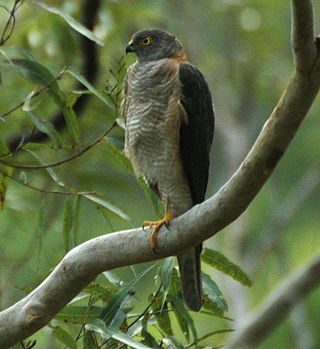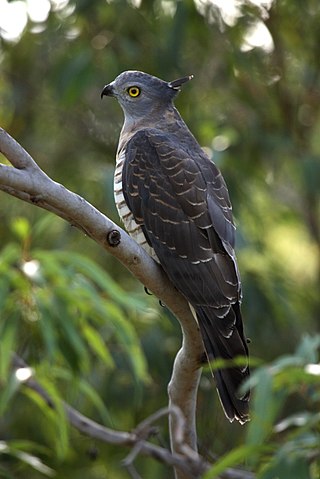
The Accipitridae is one of the three families within the order Accipitriformes, and is a family of small to large birds of prey with strongly hooked bills and variable morphology based on diet. They feed on a range of prey items from insects to medium-sized mammals, with a number feeding on carrion and a few feeding on fruit. The Accipitridae have a cosmopolitan distribution, being found on all the world's continents and a number of oceanic island groups. Some species are migratory. The family contains 255 species which are divided into 70 genera.

Accipiter is a genus of birds of prey in the family Accipitridae. With around 50 recognized species it is the most diverse genus in its family. Most species are called goshawks or sparrowhawks, although with the exception of the American goshawk almost all New World species are simply known as "hawks". They can be anatomically distinguished from their relatives by the lack of a procoracoid foramen. Two small and aberrant species usually placed here do possess a large procoracoid foramen and are also distinct as regards DNA sequence. They may warrant separation in the old genus Hieraspiza.

Aegypiinae is one of two subfamilies of Accipitridae that are referred to as Old World vultures, the other being the Gypaetinae. They are not closely related to the Gypaetinae, and are instead a sister group to the serpent-eagles (Circaetinae).

The Buteoninae are a subfamily of birds of prey which consists of medium to large, broad-winged species.

Circaetinae is a subfamily of the family Accipitridae which contains of a group of medium to large broad-winged birds of prey. The group is sometimes treated as tribe Circaetini. These birds mainly specialise in feeding on snakes and other reptiles, which is the reason most are referred to as "snake-eagles" or "serpent-eagles". The exceptions are the bateleur, a more generalised hunter, and the Philippine eagle, which preys on mammals and birds.

The Accipitrinae are the subfamily of the Accipitridae often known as the "true" hawks, including all members of Accipiter and the closely related genera Erythrotriorchis, and Megatriorchis. The large and widespread genus Accipiter includes goshawks, sparrowhawks, the sharp-shinned hawk and others. They are primarily woodland birds that hunt by sudden dashes from a concealed perch, with long tails, broad wings and high visual acuity facilitating this lifestyle. In light of recent genetic research, the kites of the traditional subfamily Milvinae may also belong to this group.

The raptor subfamily Perninae includes a number of medium-sized broad-winged species. These are birds of warmer climates, although the Pernis species have a more extensive range.

The shikra is a small bird of prey in the family Accipitridae found widely distributed in Asia and Africa where it is also called the little banded goshawk. The African forms may represent a separate species but have usually been considered as subspecies of the shikra. The shikra is very similar in appearance, as well as behavior, at least to some degree, to other species including the Chinese sparrowhawk, Eurasian goshawk and Eurasian sparrowhawk. They have a sharp two note call and have the typical flap and glide flight. Their calls are imitated by drongos and the common hawk-cuckoo resembles it in plumage. This species was formerly placed in the genus Accipiter.

The besra, also called the besra sparrowhawk, is a bird of prey in the family Accipitridae.

The black eagle is a bird of prey. Like all eagles, it is in the family Accipitridae, and is the only member of the genus Ictinaetus. They soar over forests in the hilly regions of tropical and subtropical South and Southeast Asia, as well as southeastern China. They hunt mammals and birds, particularly at their nests. They are easily identified by their widely splayed and long primary "fingers", the characteristic silhouette, slow flight and yellow ceres and legs that contrast with their dark feathers.

The crested goshawk is a bird of prey in the family Accipitridae that is widely distributed in tropical Asia. It was formerly placed in the genus Accipiter.

The Levant sparrowhawk is a small bird of prey. It measures 32–38 cm (13–15 in) in length with a wingspan of 65–75 cm (26–30 in). The female is larger than the male, but the difference is not as marked as with Eurasian sparrowhawk. The adult male is blue-grey above, with dark wingtips, and barred reddish below.

The bicolored hawk is a species of bird of prey in the family Accipitridae. It is found in forest, woodland, second growth, plantations, and wooded savanna in southeastern Mexico, Central America, and northern and central South America. Though generally uncommon, it is the most common species of Astur in most of its range, but it does not occur at altitudes above 2,700 metres (8,900 ft) such as the highest parts of the Andes.

The rufous-breasted sparrowhawk, also known as the rufous-chested sparrowhawk and as the red-breasted sparrowhawk, is a species of bird of prey in the family Accipitridae. It is found in Angola, Democratic Republic of the Congo, Eritrea, Eswatini, Ethiopia, Kenya, Lesotho, Malawi, Mozambique, Rwanda, South Africa, South Sudan, Tanzania, Uganda, Zambia, and Zimbabwe.

The scissor-tailed kite, also known as African swallow-tailed kite or fork-tailed kite, is a bird of prey in the family Accipitridae. It is the only species placed in the genus Chelictinia. It is widespread in the northern tropics of Africa.

The Harpiinae is a bird of prey subfamily which consists of large broad-winged species native to tropical forests. There are 4 genera in the subfamily, all monotypic.

Lophospiza is a genus of Asian birds of prey in the family Accipitridae. The two species placed in this genus were formerly placed in the genus Accipiter.

Tachyspiza is a genus containing goshawks and sparrowhawk in the family Accipitridae. The species were formerly placed in the genus Accipiter.

Astur is a genus containing hawks, goshawks and sparrowhawk in the family Accipitridae. The species were formerly placed in the genus Accipiter.

Aerospiza is a genus containing goshawks and a sparrowhawk in the family Accipitridae that are found in Africa. The three species in the genus were formerly placed in the genus Accipiter.




















